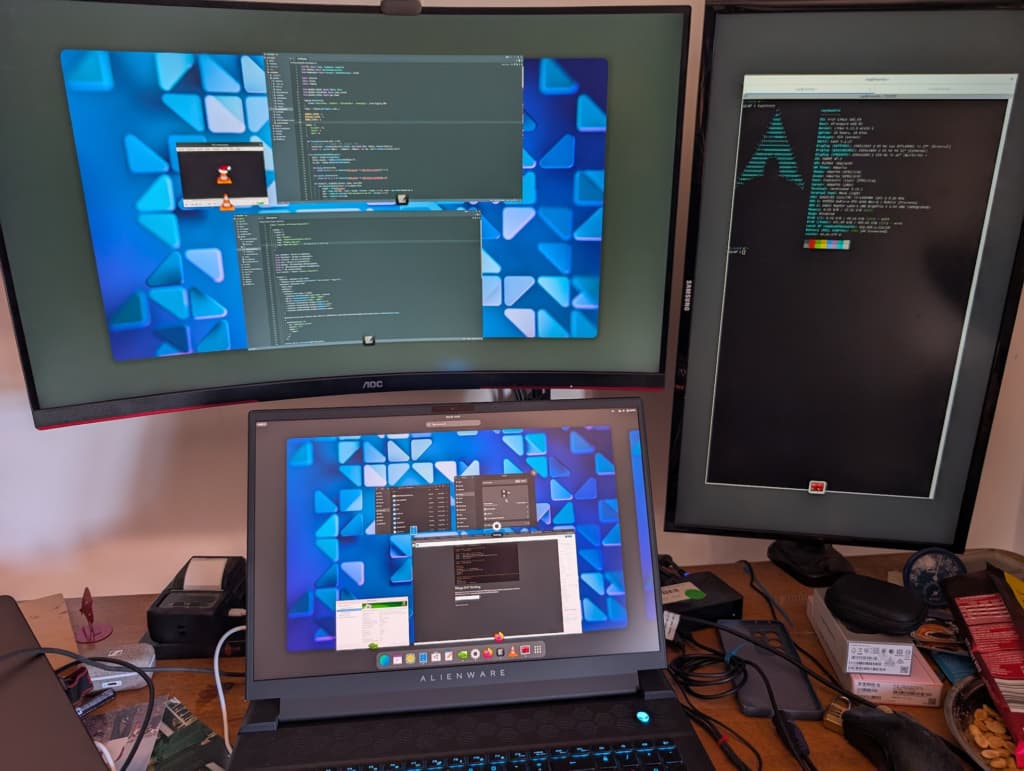As 2024 comes to its end, I decided to try Arch Linux on my new massive Alienware M18R2 laptop. The last time when I tried Arch Linux was years ago so I’d expect it’s much easier to install but probably not as easy as installing Ubuntu or Fedora
Preparation
To preserve the factory partition with Windows, I have no interest to do a dual boot. Instead I swapped the stock NVME SSD with a blank one so even disaster happens I wouldn’t lose anything. It’s relatively straight forward to open the back panel, 8 small Philips screws + 2 more for the SSD. Here’s a video for that just in case.
For the installation media, I downloaded the Arch Linux ISO and put it onto a USB key using another laptop which has Fedora Linux on it.
As the last step, I set Secure Boot mode to Audit. I think this is still a necessity to boot to Linux.
Installation
The signature steps of installing an Arch Linux are good for learning purposes but when you want to get the installation done quickly, here’s the archinstall script which was not available to me last time. It can be the only command needed once a laptop boots from the Arch Linux ISO image, after wi-fi is connected of course.
To connect to a wi-fi via command line, it can be done in just 2 commands using the provided iwctl utility
# to list wi-fi devices, which usually is just wlan0 iwctl station list # then connect to wlan0 iwctl station wlan0 connect <my-home-network> <my-password>
The archinstall is a text-based UI but it functions very similarly to a GUI installer from other Linux distributions, such as Fedora. I followed the sections and configured things like username, disk partition, desktop environment, etc. The script also offers to copy wi-fi settings to the target too.
There’s actually 1 feature that I didn’t see from popular GUI based Linux installers: at last stage, the script chroot into the target OS so I as the user can do some finalization before actually using it. In my case I used rsync to copy over my home directory from my old laptop running on Fedora Linux using rsync
rsync -v --exclude=Downloads ray@old_laptop_ip:~/ /home/ray
Post-install
First boot was surprisingly smooth, because I had no confidence in archinsall script as a first-timer. I logged in into my choice of desktop environment – Gnome 47, and almost everything works. Here are things that archinstall didn’t do for me:
# as root # NetworkManager pacman -Syu networkmanager systemctl enable --now NetworkManager.service # nVidia driver is installed by not the control panel pacman -S nvidia-settings # sound card pacman -S sof-firmware # Fonts and Pinyin input for Chinese language pacman -S wqy-bitmapfont wqy-microhei wqy-zenhei pacman -S adobe-source-han-sans-cn-fonts adobe-source-han-serif-cn-fonts pacman -S ibus-libpinyin # auto-completion for bash - yes I still use bash pacman -S bash-completion # as myself # yay for AUR sudo pacman -S --needed git base-devel git clone https://aur.archlinux.org/yay-bin.git cd yay-bin makepkg -si # install display link driver using AUR because I use a DELL USB-C dock which peripherals such as monitors and keeboard are plugged into yay evdi yay displaylink systemctl enable --now displaylink
Things NOT Working, Yet
Sound Card(solved)
Sound card is not working because it’s a Creative Labs CT9570 chipset and apparently there’s no Linux driver for it yet. I have a USB headphone amp which is supported already by Linux, so this has a workaround. I tested Ubuntu 24.04 using a USB key and I found that the integrated sound card worked perfectly out of the box which means I only need to figure out which package contains that driver. After a bit of research and guess I found this link:
https://bbs.archlinux.org/viewtopic.php?id=282148
And after I installed the sof-firmware package and rebooted once now the sound card works! Also added the command in the above list.
DisplayLink(solved)
For now the DisplayLink driver can’t bring back external monitors after the laptop suspends. I had to unplug and plug again which is inconvenient. But I needed to do that sometimes with my M3 MBP as well. Maybe it’s just how bad my old Dell dock is – I got it for $50 from eBay…
Later I figured out when reading the owner’s manual. The USB ports at side are not Thunderbolt ports. After I started to use the Thunderbolt port at back, external monitors always come back after awakened from suspension.
RGB Lighting
The RGB keyboard will flow rainbow colors during reboot and stays teal in Arch Linux. There might be a Linux counterpart of the software with which I can configure backlight colors but TBH I don’t have the interest to get this sorted now.
Will update when I find other things not working

🙂
